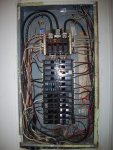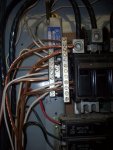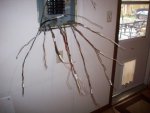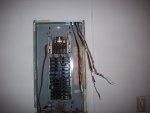Did you take and photos of the panel before you took it apart?
I always take photos before and after, love the camera phone. Told the customer what I found before changing the panel, and hooked it up the same way I found it. Panel was old and needed to be relocated
Well heres what I think, at one time these street lights were wired for 240 volts and for what ever reason someone rewired them for 120 volts, now it could have been because replaced a fixture or two with a 120 volt only fixture instead of getting the correct 240 volt or multi tap ballast (might have been just what they had on the truck?) but this may or may not have a play into the problem as it depends upon how long these runs are, if the runs are very long then you have a voltage drop problem that HID fixtures do not like, as the start up current can keep the lamp from igniting, If you are sure you have wired the circuits back to like they were I would be willing to bet that the problem was pre-existing and hes now trying to pass it onto you, I would offer to bring out a bucket truck but if you find that the problem is the above I would let him know he will be billed for it.
a few problems with voltage drop and HID lighting, while they might work right when they were brand new, after a few months they tend to not want to strike, and will cycle, depending upon how bad the VD is I have been called on lamps cycling in just a week of use, ballast will run hotter and fail more often even if they do light, there was a reason the original design called for 240 volts, and I'll bet you will find long runs?
The problem is most times we are doing a job like this we are not there at night so we have no idea if or what lights even worked when we started, but a little checking can find the trouble every time, not seeing it leave me only to speculate, but the fact that at one time these street lights were fed with 240 volts tells me something was changed, and finding why is the key to putting it back on him.
I have many times had this happen where an owner of a building thinks he can get a free repair by saying it used to work, but I flat out will tell them If I find the problem pre-existing and or something that could not have happened by me, my time will be charged, but if it was something I caused I will make the correct repairs as needed.
Also sometimes we have to educate these owners so they can understand, like if you find that these fixtures should not have been changed to 120 volt rated units explain that voltage drop will cause all sorts of problems with HID lights, if you have the photos and can print them out, it will also help show how it was wired and how it is wired now, I have a color laser printer so it cost very little for me to blow up a photo and print it.
Here is one such service panel change I did and have the photos, while a camera phone is ok, I like a much clearer photo to see detail so I have a 7meg pix Kodak digital that I keep in the truck, with a back up battery and extra SD cards, it also helps me keep a record of what I did if a question ever comes up, in these photo when I got home that night I found two errors I did, lucky it wasn't a damaging one but could have been if I didn't catch it and called the owner to shut off the two breakers both involved landing a 240 volt circuit on 120 volts, but looking at the before and after photos I saw it right away.





